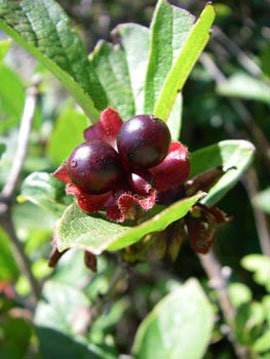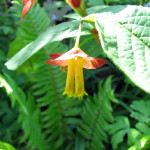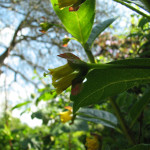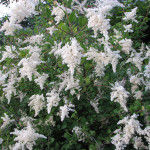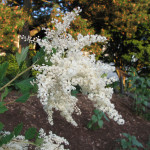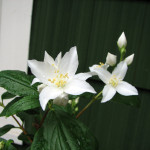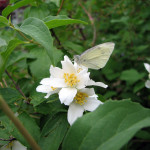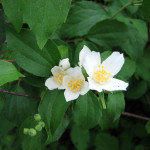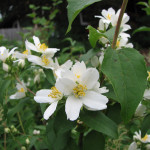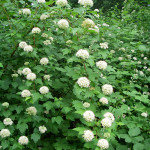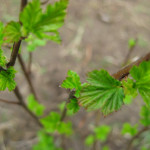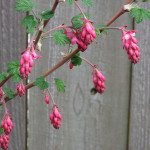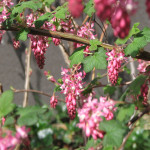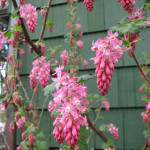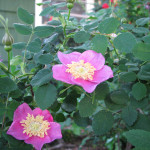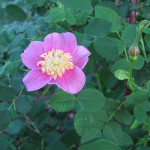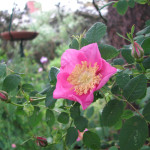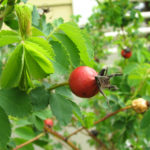Lonicera involucrata
Black twinberry (Lonicera involucrata) is also known as “twinberry honeysuckle”. Named for its pairs of flowers and fruits, this attractive shrub grows up to 10 feet tall. Tube-shaped yellow to orange flowers bloom April – July, followed by dark purple berries surrounded by showy red bracts. Young branches have yellow bark which age to yellow-brown.
The flowers provide nectar for hummingbirds and bumblebees, and the berries are eaten by numerous birds. Twinberry is also a food plant for the young of Gillette’s Checkerspot butterfly. This wetland plant grows best in sun or partial shade and moist soil.
- Light Requirements: Full Sun, Part Shade
- Water Requirements: Moist, Seasonally Wet
- Ease of Growing: Easy to grow
- Growth Rate: Moderate
- Spreads: No
- Wildlife Support: Pollinators, Hummingbirds, Birds or Mammals
- Fire-resistant: Yes
- Edible: No
- Mature Height: 8-10ft
- Mature Width:4-10ft
Salal

Gaultheria shallon
Salal is a low-growing, leathery-leaved evergreen shrub that tolerates a wide variety of conditions. Its dark blue “berries” (actually swollen sepals) are edible raw and can be made into jams, preserves, and pies. Salal berries are mildly sweet, and are often used in combination with the more tart Oregon grape.
In the Willamette Valley, salal prefers full to partial shade. In coastal areas it can form deep, nearly impenetrable thickets, and easily tolerates full sun. It grows as far north as Baranof Island, Alaska.
Salal leaves are also harvested and sold to florists worldwide for use in floral arrangements.
- Light Requirements: Part Shade, Full Shade
- Water Requirements: Dry, Moist
- Ease of Growing: Easy to grow
- Growth Rate: Moderate
- Spreads: Yes
- Wildlife Support: Pollinators, Hummingbirds, Pest-eating Insects, Birds or Mammals
- Fire-resistant: Yes
- Edible: Yes
- Mature Height: 1-5ft
- Mature Width:1-5ft
Oceanspray
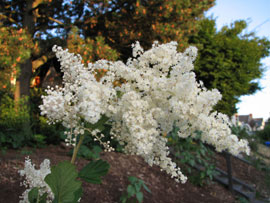
Holodiscus discolor
Oceanspray is native to western North America, most commonly found in the mountains of the Pacific Northwest. This fast-growing deciduous shrub gets 8-10′ tall and 3-7′ wide. Its small toothed leaves are 2-4 inches long. Cascading clusters of white flowers drooping from the branches give the plant two of its common names, oceanspray and creambush. The flowers have a faint sugary scent, and each one bears a small, hairy fruit containing one seed which is light enough to be dispersed by wind.
Oceanspray is found in a variety of habitats, from wet coastal forests to drier, cooler mountain peaks further inland. It often grows in areas dominated by Douglas-fir. The plant is found in areas prone to wildfire, such as chaparral communities. It is often the first green shoot to spring up in an area recovering from a burn or logging.
Many small solitary bees, bumblebees, and native butterflies visit this plant for nectar. It can also be considered a pollinator “nursery”, as pale swallowtail, spring azure, Lorquin’s admiral, and brown elfin butterflies all lay their eggs on it.
These attractive shrubs thrive on dry slopes in sun to part-sun, and spread well in favorable conditions. Long-leaf Oregon grape and salal do well in their shade, and they pair well with hazelnut to make a woodland border. Combine with red-flowering currant or vine maple for a deciduous screen.
- Light Requirements: Full Sun, Part Shade, Full Shade
- Water Requirements: Dry, Moist
- Ease of Growing: Easy to grow
- Growth Rate: Fast
- Spreads: Yes
- Wildlife Support: Pollinators, Pest-eating Insects, Birds or Mammals
- Fire-resistant: Yes
- Edible: No
- Mature Height: 8-10ft
- Mature Width:3-7ft
Tall Oregon Grape

Mahonia aquifolium (Berberis aquifolium)
Tall Oregon grape (Mahonia aquifolium) is the state flower of Oregon. The plant is not related to grapes, but gets the name from the purple clusters of berries it produces every fall. Its sharply pointed leaves resemble holly. The bright yellow clusters of flowers in April and May are both a lovely sign of spring, and a welcome sources of nectar for early pollinators including mason bees and bumblebees.
Painted lady butterflies, half-white carpet moths, mining bees, and other insects also use the flowers for food. The berries are eaten by many wildlife, including robins, waxwings, juncos, sparrows, and towhees, as well as foxes, coyotes, and raccoons.
Tall Oregon grape is well suited for low-maintenance plantings or loose evergreen hedges. It grows 5-8 feet tall depending on conditions, so in the garden it serves as a good evergreen backdrop, especially when combined with salal, sword fern, and evergreen hucklebery. Tall Oregon grape tolerates poor soils and summer drought, especially if it has some shade.
- Light Requirements: Full Sun, Part Shade
- Water Requirements: Dry, Moist
- Ease of Growing: Easy to grow
- Growth Rate: Moderate
- Spreads: Yes
- Wildlife Support: Pollinators, Hummingbirds, Pest-eating Insects, Birds or Mammals
- Fire-resistant: Yes
- Edible: Yes
- Mature Height: 5-8ft
- Mature Width:2-8ft
Mockorange

Philadelphus lewisii
Mockorange (Philadelphus lewisii) is an elegant native shrub which grows 3-9 feet tall and has a rounded form. The long stems are red when new and fade to gray with age, the older bark shredding in small flakes. Leaves are usually oval, 1-2 inches long, and a medium green.
White flowers start appearing in clusters at the ends of stems after the plant is 3-4 years old. At the height of bloom, older plants are covered in masses of sweet-smelling flowers, which have a scent similar to orange blossoms with a hint of pineapple.
This plant is as popular with wildlife as it is with people. The indra and pale swallowtail butterflies visit it for nectar, as do hummingbirds and many other pollinators. Tiger swallowtails lay their eggs on it. Birds and small mammals eat the seeds and shelter in the foliage.
Mock-orange’s green leaves turn soft yellow in autumn, contrasting beautifully with the dark green of of evergreen huckleberry and red fall foliage of Western viburnum. Add an understory of sword fern for year-round beauty and wildlife value!
- Light Requirements: Full Sun, Part Shade, Full Shade
- Water Requirements: Dry, Moist
- Ease of Growing: Easy to grow
- Growth Rate: Fast
- Spreads:
- Wildlife Support: Pollinators, Pest-eating Insects, Birds or Mammals
- Fire-resistant: Yes
- Edible: No
- Mature Height: 6-10ft
- Mature Width:4-10ft
Pacific Ninebark
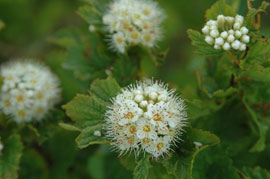
Physocarpus capitatus
Pacific ninebark (Physocarpus capitatus) is a dense deciduous shrub growing up to 12 feet tall. The name refers to the unusual bark, which naturally peels off in many colorful layers.
The shrub has maple-like lobed leaves and attractive clusters of small white flowers in May and June. The unique fruit is a glossy red pod which turns dry and brown, and then splits open to release seeds.
The twigs, berries, buds, and leaves are all browsed by wildlife. Pacific ninebark is very important for pollinators, especially solitary bees who lay their eggs and take shelter for the winter in the hollow stems. Pacific ninebark is also a food source for the young of spring azure butterflies, and many birds use it for nesting.
It is often found in wetlands, but also forms thickets along rivers and in moist forest habitats. It can also tolerate some drought. Create a dense deciduous screen by growing it in combination with oceanspray and Douglas spirea. Best in full sun to part shade.
- Light Requirements: Part Shade
- Water Requirements: Moist, Seasonally Wet
- Ease of Growing: Easy to grow
- Growth Rate: Fast
- Spreads: Yes
- Wildlife Support: Pollinators, Pest-eating Insects, Birds or Mammals
- Fire-resistant: Yes
- Edible: No
- Mature Height: 8-12ft
- Mature Width:4-7ft
Red Flowering Currant
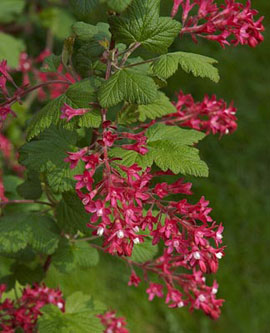
Ribes sanguineum var. sanguineum
Red flowering currant (Ribes sanguineum) is an upright, multi-stemmed deciduous shrub that can get 6-10 feet tall, and is considered one of our prettiest native shrubs. Its bright pink, dangling flower clusters in late February and March are welcome signs of spring!
The bark is dark brownish-grey with pale brown lenticels. The palmate leaves have five lobes, and young leaves and flowers have a scent variously described as spicy or resinous. The fruits form as clusters of dark purple berries which contrast beautifully with the rosy gold fall foliage.
Keep a pair of binoculars handy if you plant this lovely shrub, because red flowering currant is a favorite of hummingbirds and other wildlife all year long. The flowers are important early spring nectar sources for rufous and Anna’s hummingbirds, spring azure and mourning cloak butterflies, and many native bees. Many birds eat the berries in the fall and winter, including towhees, thrushes, cedar waxwings, and sparrows. This charming plant also hosts the eggs of zephyr butterflies, and provides shelter for songbirds.
Red flowering currant can tolerate shade, but grows best (and blooms the most) in sunny locations with well drained soils.
- Light Requirements: Full Sun, Part Shade
- Water Requirements: Dry, Moist
- Ease of Growing: Easy to grow
- Growth Rate: Fast
- Spreads:
- Wildlife Support: Pollinators, Hummingbirds, Pest-eating Insects, Birds or Mammals
- Fire-resistant: Yes
- Edible: Yes
- Mature Height: 4-10ft
- Mature Width:3-10ft
Nootka Rose
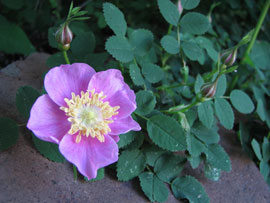
Rosa nutkana var. nutkana
The Nootka rose is an attractive shrub growing up to 9′ high. The straight, erect stems are usually green, but occasionally may be reddish. The prickles are larger and thicker than those of the other native rose species.
The leaves are alternate on the stems and pinnately compound with 5-7 leaflets, dark green above, paler and slightly hairy below. The leaflets are elliptic or ovate in shape with serrate margins, and range from 1-7 cm long and 0.7-4.5 cm wide.
The sweet-scented, pink flowers are usually solitary, occasionally growing in groups of 2 or 3. They are large and showy, ranging from 5-8 cm across. Individual petals are 2.5-4 cm long, and 5 petals are the norm for the flowers. The rose hips are spherical, orange-red and large, ranging from 1-2 cm wide.
Uses
Wild rose is spindly and tends to form loose thickets, which in large spaces makes it useful as a hedgerow or as a wildlife-friendly ornamental. The leaves and fruits are important food sources for herbivores and upland game birds, and rose thickets provide excellent nesting and escape habitat for songbirds. The plant also has many traditional uses in Native American culture. Rose hips can be made into jam, tea, and used as flavoring, and the leaves have a variety of medicinal uses. Dried flower petals are used for scents and potpourri.
Habitat
Nootka rose may be found in open upland woods or in open shrub wetlands. In areas where both Rosa nutkana and Rosa woodsii occur, the former may be found at higher elevations and often in woods.
- Light Requirements: Full Sun, Part Shade
- Water Requirements: Dry, Moist, Seasonally Wet
- Ease of Growing: Easy to grow
- Growth Rate: Moderate
- Spreads: Yes
- Wildlife Support: Pollinators, Pest-eating Insects, Birds or Mammals
- Fire-resistant: Yes
- Edible: Yes
- Mature Height: 6-10ft
- Mature Width:3-4ft

